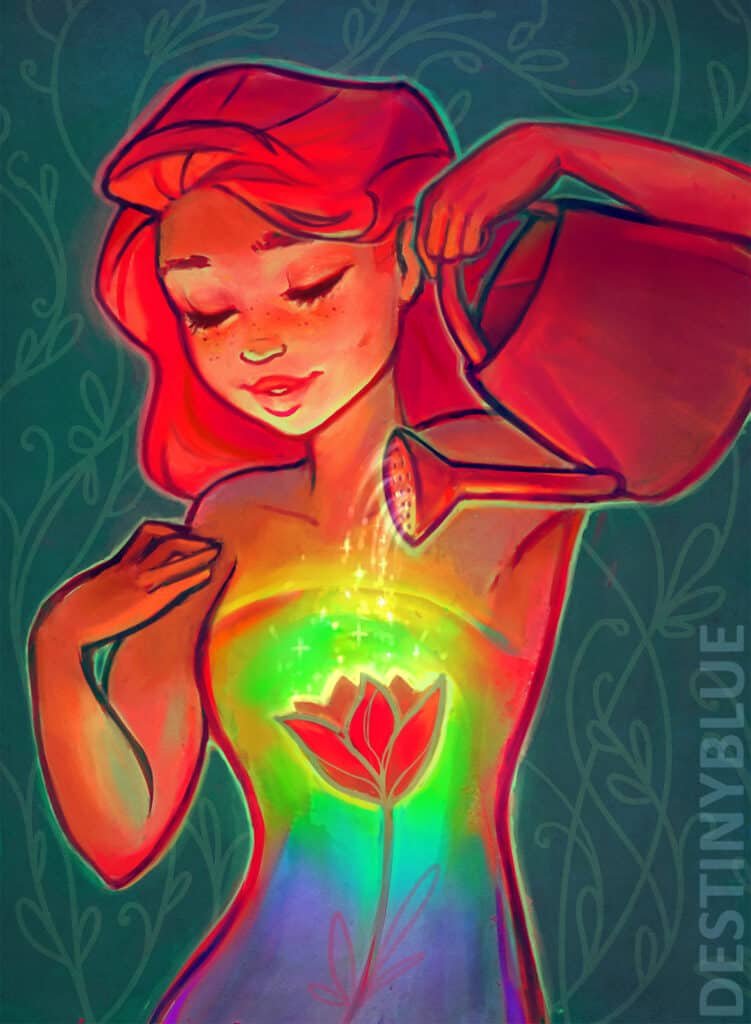
Image source –
https://www.deviantart.com/destinyblue/art/Self-Care-685625852
“The wound is the place where the light enters you” – Rumi
Pandora hurriedly tried to shut the lid of the box of horrors to ensure that the darkness no longer escapes. But the deed had already been done. Moments later she heard a calm voice, gently requesting her to let it out. Hope saw light when Pandora followed her intuition. Darkness was followed by light and day followed night.
In a trauma inducing situation self-care is the antidote; a conscious choice to let out the hope of thriving in a fight or flight situation. When the going gets tough, the tough may not always get going. The decision to get going however, is to acknowledge the presence of the wound and accept the box of darkness as a gift to usher in positive change.
As part of the survival kit, many of us tend to look after our basic needs. Deep work self-care is going beyond what meets our materialistic wants and needs. The question which arises here is how we decide what the body wants versus what it needs. Perhaps we could ask, what does it require?
In expressive art theory and practice the body takes centre stage. What we feel and experience as part of it is more than what meets the eye. The intermodal techniques which led to Paolo Knill developing his crystallization theory, establishes ways in which an art medium can facilitate psychic material in coming into “optimal clarity, precision of feeling and thought.”. The arts, therefore, are a reliable and verified tool one can adopt to practice self-care and support the optimal functioning of the nervous system. When we ‘decentre’ to ‘see’ material and our life experiences in new light, we generate solutions and new resources for a healthy living.
A preferred start to adopting sustainable life force inducing self-care practices in one’s routine is to become conscious and aware of one’s limitations and setbacks. That lays the possible foundation for the willingness to change. Caring for one’s body and spirit begins here. It is the nervous system’s natural response to protect and ensure survival. Hence, familiar behavioural patterns will prevent us from exploring our pathos and deep-rooted trauma to reclaim parts of the self which have been lost over years. Going inwards is the temporary suspension of linear thinking. This journey to dare leave known ground and challenge accustomed patterns, we need tools that will help us connect with our creative energy. The development of consciousness and bodily awareness is one that can be accomplished through self-sustaining deep work.
When we improvise through creativity, art and therapy we relate to what is in the moment and what is available in our immediate environment. Blocked emotions, old patterns and fears are released. Committing to self-care through this process activates a few elements (Daria Halprin, 2003). These one could consider while submitting to any self-care practice-
- To fully commit to what we choose to do
- Staying open
- Responding to how your body feels
- Working with what attracts you
- Paying attention to relevant details
- Developing on what arises so you can fully express
- Repeating your actions or practice until things become clear
- Staying with a practice or activity because it is interesting or until finished.
- Shifting from one activity to another to increase diversity and create transitions
- Drop tasks that no longer serve you purpose or those that are finished, to create space for new.
- Maximising use of all available resources.
This shift from one state to another is achievable through embodied practice. Sometimes such practice to adopt new behaviours, purposeful patterns may not evoke joy or feel good. It is challenging and can cause anxiety, to start a practice one maybe unfamiliar with. However, the rewards reaped over time are far greater than the temporary fear of change.
In lay terms, self-care isn’t always about a spa day or a day off from work. Deep work self-care could be potentially discomforting and adopting a whole new altered mindset. However, the greater the difficulty and sometimes, deeper the cut the light penetrates all the way through. The healing becomes magical.
Somatic practitioner Sara Baldwin advocates three ways we can support our nervous system- The three avenues for Regulation-
- Self- regulation – What can I do on my own to feel more present/safe/capable/able/curious/grounded?
One could consider moving their body, listening to music, breathing techniques, being in nature, self-touch, or anything which makes us feel ‘in the now.’
- Co-regulation- Connect to someone else’s nervous system to help yours come into regulation.
Consider receiving a hug, being heard, time spent with loved ones, being around pets/animals, watching characters on television which make us feel ‘safe’ etc.
- Internal Co-regulation – The process by which we activate our more competent adult parts to support our younger parts (inner child, younger self) via attunement and a safe connection. This gives our younger parts, the unhealed neglected parts to feel safe and gives the connection they have been longing for and deserve. What Peter Levine says, “it’s never too late to have the childhood we deserve.”
This concept of holistic well-being has been promoted through sustainable self-care. According to the World Health Organization, self-care is, “the ability of individuals, families, and communities to promote health, prevent disease, maintain health, and to cope with illness and disability with or without the support of a healthcare provider.” Self-care cannot be clubbed in a compartment of merely tending to one’s physical and mental needs. It is the act of accepting the need to let go and release purposeless behaviour that denies us the right to an intentionally balanced life. The box of darkness we receive, can be perceived as alarming or threatening (Mary Oliver, The Uses of Sorrow 2007), but recognizing the innate ability to view it as a gift, and doing so is step one to a sustainable life. Authentic self-care is not something companies and brands would market. It is hard work and healthy choices we make which reflect true self-compassion. It is for everyone of every age and doable anytime
Sohini is an educator, artist and mental health advocate. After being a teacher for almost a decade she found her calling again and decided to pursue a career in creative art therapies. When she’s not busy guiding her young learners, Sohini writes on mental health awareness, paints and reads nonfiction. She lives in Kolkata with her mother.

